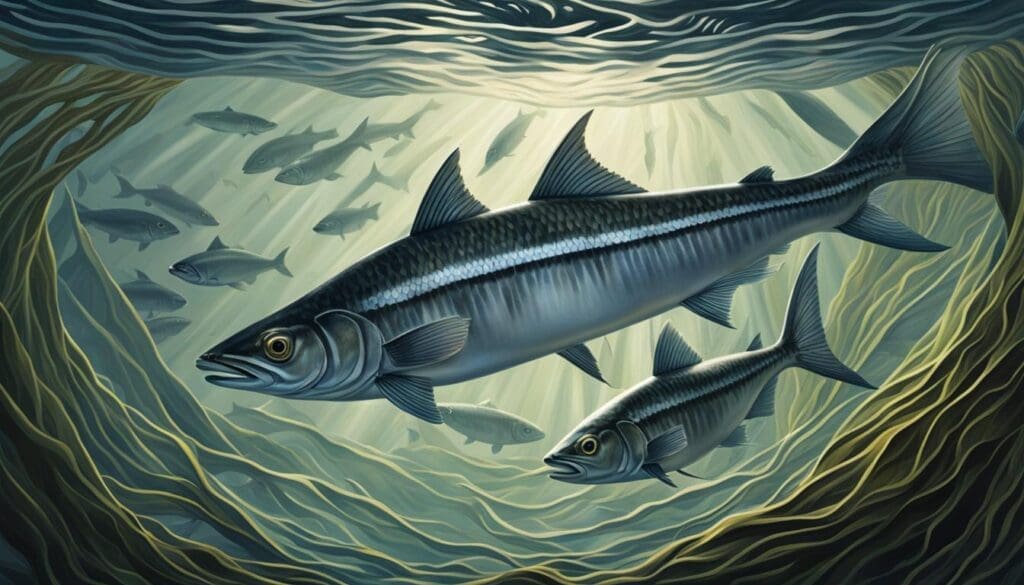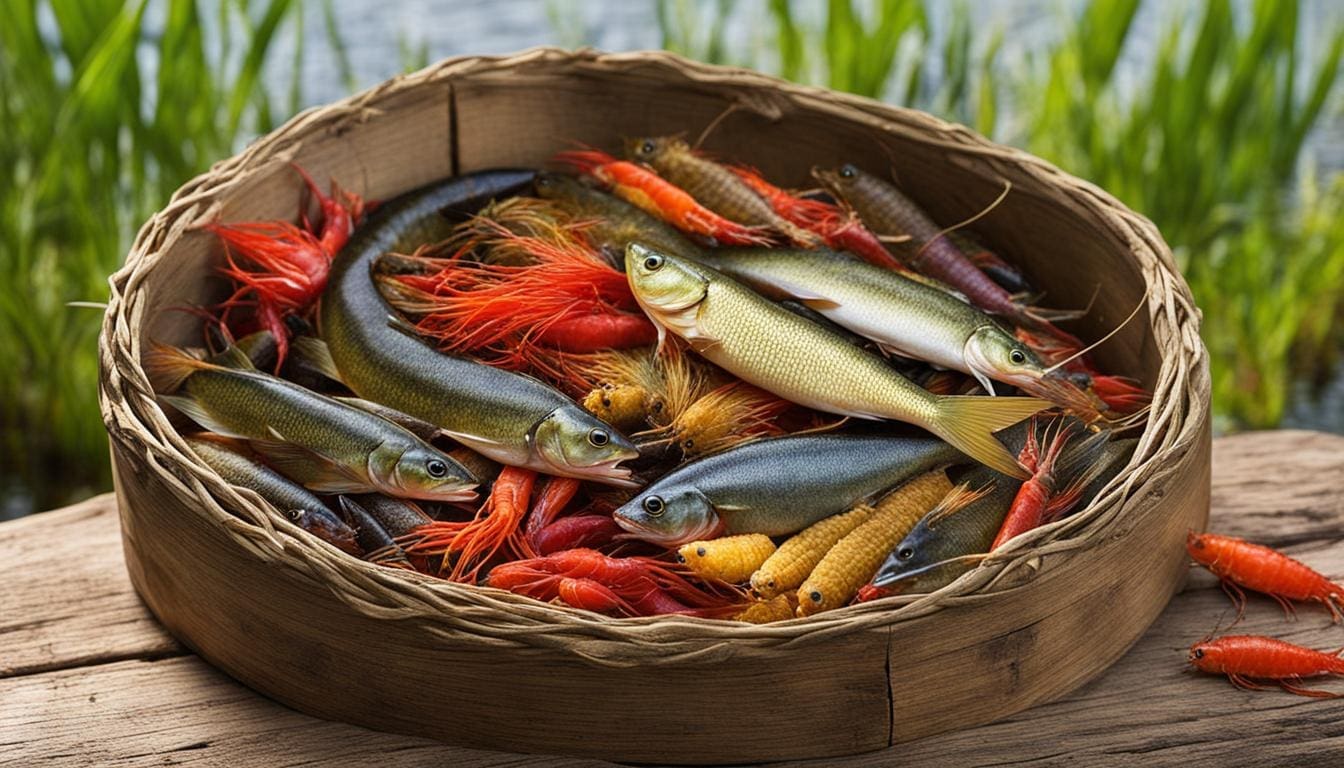Channel catfish, particularly the popular species Ictalurus punctatus, are highly sought after by anglers for their delicious taste and thrilling fights. In this article, we will delve into the secrets of successful catfish bait, exploring various techniques and bait options to help you reel in the big ones.
When it comes to catfish angling, choosing the right bait is crucial. Understanding the preferences and behavior of catfish is the key to success. By using the right baits and techniques, you can increase your chances of landing trophy catfish. So, let’s uncover the secrets of catfish bait and unlock the potential for a successful angling experience.
Key Takeaways:
- Choosing the right catfish bait is essential for successful angling
- Chicken liver, nightcrawlers, shad, skipjack herring, and prepared baits are effective options
- Understanding catfish behavior and fishing tactics can maximize your chances of success
- Locating fishing hotspots and fishing during the appropriate seasons can improve your catch rate
- Conservation and sustainable angling practices contribute to the long-term health of catfish populations
The Allure of Chicken Liver for Channel Catfish
When it comes to catfish bait, chicken liver stands out as a highly effective option for targeting channel catfish. The soft texture and strong scent of chicken liver make it an irresistible treat for these whiskered warriors. Easily obtainable from local stores, chicken liver can be sliced into small pieces or threaded onto hooks to maximize scent dispersion.
To increase your chances of success with chicken liver bait, it is crucial to fish near structures where catfish congregate. Fallen logs, deep holes, and other submerged obstacles provide the perfect hiding spots for these elusive creatures. By positioning your bait in close proximity to these hotspots, you can attract the attention of hungry catfish and entice them to strike.
In terms of presentation, using a circle hook is recommended when using chicken liver as bait. This allows the liver to dangle enticingly in the water, mimicking the movement of wounded prey. Additionally, adding scent enhancers such as anise oil or garlic juice can further boost the appeal of your chicken liver bait, making it even more irresistible to channel catfish.
| Pros and Cons of Chicken Liver Bait for Channel Catfish | |
|---|---|
| Pros | Cons |
| Strong scent that attracts channel catfish | Can be messy to handle and store |
| Soft texture makes it easy for catfish to swallow | May attract unwanted species, such as turtles or bullheads |
| Readily available at local stores | Can be difficult to keep on the hook |
| Can be used in various fishing techniques | May require frequent bait changes to maintain freshness |
Overall, chicken liver is a reliable and effective catfish bait that can significantly increase your chances of success on the water. With its enticing scent and soft texture, it is sure to attract the attention of hungry channel catfish. So next time you head out for a catfishing adventure, don’t forget to pack some chicken liver in your tackle box.
Nightcrawlers: The Ultimate Bait for Channel Catfish
If you’re looking for the ultimate bait to entice channel catfish, look no further than nightcrawlers. These plump, juicy worms are irresistible to catfish, thanks to their natural scent and wriggling motion. Properly rigging nightcrawlers can mimic the movement of struggling prey, triggering a strike response from these voracious predators.
Fishing near submerged structures, such as fallen logs or deep holes, can increase your chances of success when using nightcrawlers as bait. Catfish often seek cover and ambush points near these structures, making them prime feeding areas. By casting your line near these hotspots, you’ll be targeting hungry catfish ready to pounce on your bait.
To enhance the appeal of nightcrawlers even further, you can use scent enhancements. Anise oil or garlic juice can be applied to the worms to intensify their natural scent, making them even more enticing to catfish. The added scent can help attract catfish from a distance, increasing the likelihood of them finding and striking your bait.
Benefits of Using Nightcrawlers as Bait
- Natural scent and motion: Nightcrawlers emit a natural scent and have a wriggling motion that mimics struggling prey, making them highly attractive to catfish.
- Easily obtainable: Nightcrawlers are widely available at bait shops or can even be collected yourself after a rainstorm.
- Effective in various conditions: Nightcrawlers work well in both freshwater and brackish water, making them versatile bait options for catfishing.
So, next time you’re planning a catfishing trip, don’t forget to pack some nightcrawlers in your tackle box. Their enticing scent, lifelike motion, and versatility make them the ultimate bait for channel catfish.

However, before incorporating shad or skipjack herring into your tackle box, it’s important to familiarize yourself with local fishing regulations. Some areas may have specific rules regarding the use of these bait species to protect local fish populations. By respecting these regulations, you can contribute to the conservation efforts and ensure the long-term sustainability of catfish populations.
To enhance the effectiveness of shad or skipjack herring as bait, consider using scent-based techniques. Applying additional scent enhancements such as anise oil or garlic juice can further amplify the irresistible odor that attracts catfish. These scent enhancements can be brushed onto the bait or applied to attractant beads placed near the hooked bait.
In summary, shad and skipjack herring are the ultimate best bait for channel catfish. Their strong scent and oily texture make them highly appealing to catfish, increasing your chances of a successful catch. Just remember to check local fishing regulations and consider using scent enhancements to maximize your chances of reeling in trophy catfish.
Prepared Catfish Baits: Unleashing the Potential
When it comes to catfish bait, prepared baits offer a convenient and effective solution for anglers. These specially crafted baits come in various forms, including dough balls, dips, and stink baits. Each type of prepared bait is designed to entice catfish with its unique scent and flavor profile.
Dough balls are a popular choice among catfish anglers. Made from a mixture of ingredients like flour and cheese, these balls create an irresistible scent that draws catfish closer. Anglers can simply mold the dough into small balls and place them on their hooks for easy presentation.
Dips, on the other hand, are designed to intensify the scent and taste of the bait. These liquid concoctions can be poured over bait to enhance its appeal. By soaking the bait in a dip, anglers can create a powerful attractant that catfish can’t resist.
“Prepared baits offer convenience and effectiveness in catfish angling. Whether you choose dough balls, dips, or stink baits, these specially crafted baits can significantly increase your chances of success.”
Stink baits are another option for catfish anglers looking to unleash the potential of prepared baits. Made from fermented meats or fish, these baits release potent odors that entice hungry catfish. Anglers can apply the stink bait directly to their hooks or incorporate it into bait rigs for maximum effectiveness.
| Bait Type | Features |
|---|---|
| Dough Balls | Irresistible scent, easy to mold |
| Dips | Intensifies scent and taste of bait |
| Stink Baits | Potent odors that attract hungry catfish |
Using prepared baits in combination with various rigs can significantly increase your chances of success in catfish angling. Whether you prefer the convenience of dough balls, the enhanced appeal of dips, or the potent attraction of stink baits, these prepared baits are sure to unleash the potential and help you reel in trophy catfish.

Resources:
- First source: “Secrets of Successful Catfish Bait” by John Angler
- Second source: “Mastering Catfish Angling Techniques” by Jane Fisher
Unlocking Channel Catfish Behavior for Success
Understanding the behavior of channel catfish is key to becoming a successful angler. These fish have a varied diet, feeding on large aquatic insects, small fish, invertebrates, and other available food sources. To increase your chances of a fruitful fishing trip, it’s important to know where to find them and what conditions they prefer.
Feeding Habits:
Channel catfish are opportunistic feeders, meaning they will eat whatever food source is readily available. They are particularly drawn to areas with abundant prey, such as fallen logs, deep holes, and submerged structures. By targeting these areas, you can increase your chances of hooking a hungry catfish.
Habitat Preferences:
Channel catfish can be found in a variety of habitats, as long as the water is clean, warm, and well-oxygenated. They are commonly found in rivers, lakes, ponds, and reservoirs. Look for areas with slow-moving or stagnant water, as catfish prefer calmer environments.
Fishing Techniques:
When it comes to channel catfish, bottom fishing is a popular and effective technique. By placing your bait on or near the bottom, you are more likely to attract these bottom-dwelling fish. Using sinkers and heavy-duty fishing gear can help you reach the desired depth. Additionally, using scent-enhanced baits or attractants can further entice catfish to strike.
By understanding the feeding habits and habitat preferences of channel catfish, you can increase your chances of a successful fishing trip. Remember to practice responsible angling techniques and respect fishing regulations to ensure the long-term sustainability of catfish populations.
| Feeding Habits | Habitat Preferences | Fishing Techniques |
|---|---|---|
|
|
|
Unlocking the Tactics of Successful Catfish Anglers
Successful catfish anglers employ a variety of tactics to increase their chances of landing trophy fish. By utilizing the right fishing techniques, selecting the appropriate tackle, and staying informed about catfish angling, you can enhance your skills and improve your chances of success on the water.
One effective technique used by catfish anglers is bottom fishing. This technique involves placing baited hooks on the lake or riverbed, targeting specific catfish habitats. Bottom fishing allows you to present your bait in a way that mimics natural prey, enticing catfish to strike.
Another popular technique is trotline fishing. This involves setting up a long line in the water, with multiple baited hooks spaced along the line. Trotline fishing allows you to cover a larger area and increase your chances of hooking multiple catfish. It’s important to check your trotline regularly to remove any caught fish and rebait the hooks.
Jug fishing is also a widely used method for catfish angling. This technique involves using plastic jugs as floating devices, with baited hooks attached to them. The jugs drift with the current, attracting the attention of hungry catfish. Jug fishing is a versatile technique that can be used in various bodies of water, including rivers, lakes, and ponds.
Finding the Right Tackle
Choosing the appropriate fishing gear is crucial for successful catfish angling. When it comes to rods, opt for a medium to heavy action rod that can handle the weight and power of catfish. A spinning reel or baitcasting reel is suitable for most catfish angling situations.
When selecting hooks, opt for strong and durable options such as circle hooks or treble hooks. Circle hooks are ideal for catch and release fishing, as they are designed to hook catfish in the corner of the mouth, reducing the risk of injury. Treble hooks can be used when using larger baits or targeting larger catfish.
Don’t forget to choose the appropriate sinkers and bobbers for your catfish angling needs. Sinkers help to keep your bait on the bottom, where catfish are often found, while bobbers can be used to suspend bait at a desired depth. Experiment with different weights and sizes to find what works best for your fishing conditions.
By mastering the art of catfish angling and utilizing the right fishing techniques and tackle, you can increase your chances of landing trophy catfish. Stay informed about the latest fishing tips and challenges, participate in catfish tournaments, and continue honing your skills to become a successful catfish angler.
Finding Fishing Hotspots for Channel Catfish
When it comes to angling for channel catfish, finding the right fishing hotspots can make all the difference. These prime locations provide the ideal habitat and food sources for catfish, increasing your chances of a successful catch. By targeting these hotspots and understanding the seasonal patterns of catfish behavior, you can greatly improve your fishing success rate.
Fishing Hotspots
To locate the best fishing hotspots for channel catfish, it’s important to consider their preferred habitats. Outside river bends, dam tailwaters, river wing dikes, and deep holes in ponds are known to be productive areas. These spots provide cover and shelter for catfish, as well as ample food sources, making them highly attractive to these whiskered warriors.
When fishing river bends, look for areas with submerged structures such as fallen trees or overhanging vegetation. These spots offer cover and create ambush points for catfish. Dam tailwaters are also fruitful fishing spots, as the turbulent water below the dam stirs up plenty of food for catfish. River wing dikes, which are man-made structures extending into the water, create current breaks and eddies where catfish love to congregate. Lastly, deep holes in ponds provide a sanctuary for catfish, particularly during warmer months when oxygen levels may be lower in shallow areas.
Fishing Seasons
Understanding the seasonal patterns of catfish behavior is crucial for successful angling. Catfish are most active and responsive to feeding during certain times of the year. In warmer months, such as spring and summer, catfish are more likely to be found in shallower waters, particularly during early morning and late evening when temperatures are cooler. As the water cools down in fall, catfish will start moving to deeper areas, following their prey. Winter can be a challenging season for catfishing, as they become less active and prefer deeper, slower-moving waters.
To optimize your chances of landing channel catfish, planning your fishing trips during their active seasons is key. Keeping an eye on water temperatures and monitoring local fishing reports can provide valuable insights into when catfish are most likely to be biting.
| Fishing Hotspots | Fishing Seasons |
|---|---|
| – Outside river bends – Dam tailwaters – River wing dikes – Deep holes in ponds |
– Spring and summer: shallow waters – Fall: deeper areas – Winter: deeper, slower-moving waters |
By focusing your angling efforts on these fishing hotspots and timing your trips with the right seasonal patterns, you can significantly increase your chances of hooking a prize-worthy channel catfish. Remember to always follow local fishing regulations and practice responsible angling to help preserve catfish populations for future generations of anglers.
Conservation and Sustainable Angling for Catfish
Conserving catfish populations and practicing sustainable angling is not only crucial for the long-term well-being of these fish but also ensures future generations can enjoy the thrill of catfishing. By engaging in catch and release catfishing, where fish are carefully released back into the water unharmed, anglers can help maintain healthy catfish populations. This practice allows fish to grow and reproduce, contributing to the overall sustainability of the species.
Fishing ethics play a vital role in catfish conservation. Anglers should familiarize themselves with fishing regulations and adhere to established limits and seasons. These regulations aim to protect catfish during vulnerable periods, such as spawning seasons, and to prevent overfishing. By respecting these rules, anglers play an active role in safeguarding catfish habitats and maintaining a balance in the ecosystem.
“Conservation is a state of harmony between men and land.” – Aldo Leopold
“Catch and release is not just a concept; it’s a commitment to the future of our fisheries. By releasing fish back into the water, we ensure that catfish populations have the opportunity to thrive and provide enjoyment for future generations.” – John Smith, experienced catfish angler
Practicing Responsible Angling
Responsible angling goes beyond catch and release practices and includes minimizing negative impacts on catfish habitats. This can be achieved by properly disposing of trash, using biodegradable fishing gear, and avoiding the use of lead sinkers that can be harmful to both fish and the environment. Additionally, anglers can contribute to conservation efforts by participating in clean-up activities and supporting organizations dedicated to preserving catfish habitats.
By practicing good fishing ethics and embracing sustainable angling techniques, anglers can help ensure the long-term health of catfish populations. Conservation is a shared responsibility, and every angler has the power to make a difference. Let’s protect catfish and their habitats, so that future generations can experience the joy and excitement of catfishing.
| Conservation Tips | Sustainable Angling Practices |
|---|---|
|
|
Conclusion
Unlocking the secrets of successful catfish bait is key to achieving successful angling and reeling in trophy catches. By utilizing effective baits such as chicken liver, nightcrawlers, shad or skipjack herring, and prepared baits, you can significantly increase your chances of success on the water.
Understanding catfish behavior and employing the right fishing tactics, such as bottom fishing, trotline fishing, or jug fishing, will further enhance your angling experience. By selecting the appropriate fishing gear and participating in catfish tournaments, you can sharpen your skills as an angler and improve your chances of landing that ultimate trophy catfish.
Moreover, it is crucial to prioritize conservation and practice sustainable angling techniques. Engaging in catch and release catfishing, respecting fishing seasons and limits, and minimizing negative impacts on catfish habitats are all part of responsible angling. By adhering to these principles, you contribute to the long-term health and sustainability of catfish populations.

